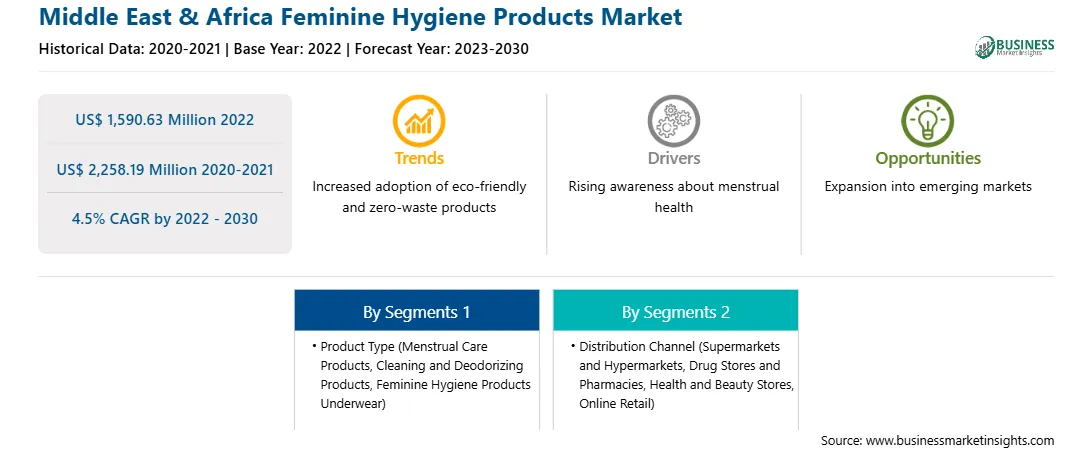中东和非洲女性卫生产品市场预测至 2030 年 - 区域分析 - 按产品类型 [经期护理产品(卫生巾、卫生棉条、月经杯等)、清洁和除臭产品(脱毛产品、卫生洗涤剂) 、亲密喷雾等)、女性卫生用品内衣(可重复使用的经期内衣、可重复使用的失禁内衣等)];和分销渠道(超市和大卖场、药店和药房、保健和美容店、在线零售等)
No. of Pages: 89 | Report Code: BMIRE00029205 | Category: Consumer Goods
No. of Pages: 89 | Report Code: BMIRE00029205 | Category: Consumer Goods
由于该地区消费者对可持续发展的关注日益增加,环保且可重复使用的女性卫生用品越来越受欢迎。女性卫生用品的不可生物降解性是一个主要的环境问题。因此,环保的卫生巾、护垫和卫生棉条等天然纤维制成的女性卫生用品是一个可行的选择。有机棉、黄麻、香蕉纤维和竹子都属于天然吸水纤维。它们用途广泛且可生物降解,碳足迹极小。使用这些纤维还可以降低女性卫生产品的生产成本。这些天然纤维的吸收性和保留特性使其成为优于传统纤维的首选。香蕉纤维、竹纤维、黄麻纤维和纤维素基水凝胶的组合与合成高吸水性聚合物(SAP)具有相似的吸收率。同样,可以使用由淀粉制成的生物基塑料代替不可生物降解的聚乙烯和聚氨酯作为阻挡片。一些生产环保产品的公司包括 Shethinx、Saaltco 和 Weeredame。例如,Boots 销售的植物性涂抹卫生棉条既经济实惠又环保。此外,公司正在采用新技术,推出可重复使用的护垫和卫生巾,这些护垫和卫生巾不渗透、不含氯、可重复使用/可清洗。此次发布解决了塑料人口不断增加以及中东和非洲地区的问题。非一次性卫生棉条导致非洲变暖。因此,可重复使用且环保的女性卫生产品的日益普及预计将在预测期内创造市场新趋势。
中东和非洲非洲女性卫生用品市场分为南非、沙特阿拉伯、阿联酋以及中东其他地区和地区。非洲。政府对女性保健的日益重视、生活方式质量的提高以及女性卫生意识的提高是该地区女性卫生用品市场的关键驱动因素。 2018年2月,供水和卫生合作委员会(WSSCC)与联合国妇女署合作,在西非塞内加尔、尼日尔和喀麦隆三个国家实施了一项名为“性别、个人卫生和环境卫生”的联合项目。该计划旨在为这些国家的妇女制定健康、个人卫生和环境卫生政策,并促进经期卫生管理 (MHM)。此外,AFRIpads、Qrate、ZanaAfrica、Pad-Up Africa、Sanitary Aid Initiative 和 Speak Up Africa 等妇女福利组织正在采取措施,在农村和城市地区提供卫生援助和经期卫生教育。 AFRIpads 于 2010 年在乌干达的一个乡村成立,生产可重复使用的卫生巾,并与联合国儿童基金会和救助儿童会等组织合作,以改善非洲的经期健康。此外,他们还创作并发行了“Girl Talk”等节目。一本漫画小册子,以引人入胜且易于理解的方式解释月经期。各国政府和组织的此类举措促进了该地区女性卫生用品市场的增长。
中东和非洲非洲女性卫生用品市场分为产品类型、分销渠道和国家。
根据产品类型,中东和非洲地区是女性卫生用品市场的主要市场。非洲女性卫生用品市场分为经期护理产品、清洁和除臭产品以及女性卫生内衣。经期护理产品领域在中东和非洲地区注册人数最多。 2022 年非洲女性卫生用品市场份额。
根据分销渠道,中东和非洲地区女性卫生用品市场份额非洲女性卫生用品市场分为超市和大卖场、药店和药房、保健和美容店、在线零售等。其他细分市场在 2022 年占据最大的市场份额。
按国家/地区、中东和非洲地区划分。非洲女性卫生用品市场分为南非、沙特阿拉伯、阿联酋和中东其他地区。非洲。中东其他地区和非洲主导中东和非洲2022 年非洲女性卫生用品市场。
Edgewell Personal Care Co、Essity AB、Kimberly-Clark Corp、Lune Group Oy Ltd、Mooncup Ltd、Ontex BV 和 The Procter & Gamble Co 是该地区女性卫生用品市场的一些领先公司。
Strategic insights for Middle East & Africa Feminine Hygiene Products involve closely monitoring industry trends, consumer behaviours, and competitor actions to identify opportunities for growth. By leveraging data analytics, businesses can anticipate market shifts and make informed decisions that align with evolving customer needs. Understanding these dynamics helps companies adjust their strategies proactively, enhance customer engagement, and strengthen their competitive edge. Building strong relationships with stakeholders and staying agile in response to changes ensures long-term success in any market.

| Report Attribute | Details |
|---|---|
| Market size in 2022 | US$ 1,590.63 Million |
| Market Size by 2030 | US$ 2,258.19 Million |
| Global CAGR (2022 - 2030) | 4.5% |
| Historical Data | 2020-2021 |
| Forecast period | 2023-2030 |
| Segments Covered |
By 产品类型
|
| Regions and Countries Covered | 中东和非洲
|
| Market leaders and key company profiles |
The regional scope of Middle East & Africa Feminine Hygiene Products refers to the geographical area in which a business operates and competes. Understanding regional nuances, such as local consumer preferences, economic conditions, and regulatory environments, is crucial for tailoring strategies to specific markets. Businesses can expand their reach by identifying underserved regions or adapting their offerings to meet regional demands. A clear regional focus allows for more effective resource allocation, targeted marketing, and better positioning against local competitors, ultimately driving growth in those specific areas.

The Middle East & Africa Feminine Hygiene Products Market is valued at US$ 1,590.63 Million in 2022, it is projected to reach US$ 2,258.19 Million by 2030.
As per our report Middle East & Africa Feminine Hygiene Products Market, the market size is valued at US$ 1,590.63 Million in 2022, projecting it to reach US$ 2,258.19 Million by 2030. This translates to a CAGR of approximately 4.5% during the forecast period.
The Middle East & Africa Feminine Hygiene Products Market report typically cover these key segments-
The historic period, base year, and forecast period can vary slightly depending on the specific market research report. However, for the Middle East & Africa Feminine Hygiene Products Market report:
The Middle East & Africa Feminine Hygiene Products Market is populated by several key players, each contributing to its growth and innovation. Some of the major players include:
The Middle East & Africa Feminine Hygiene Products Market report is valuable for diverse stakeholders, including:
Essentially, anyone involved in or considering involvement in the Middle East & Africa Feminine Hygiene Products Market value chain can benefit from the information contained in a comprehensive market report.